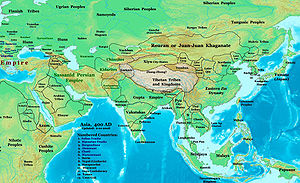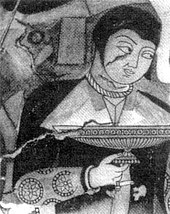Xionites

Xionites, Chionites, or Chionitae (
The Xionites appear to be synonymous with the
They were first described by the Roman historian,
Within the Xionites, there seem to have been two main subgroups, which were known in the
Origins and culture
The original culture of the Xionites and their geographical
Differences between the Xionites, the Huns who invaded Europe in the 4th century, and the Turks were emphasised by Carlile Aylmer Macartney (1944), who suggested that the name "Chyon", originally that of an unrelated people, was "transferred later to the Huns owing to the similarity of sound". The Chyon who appeared in the 4th century, in the steppes on the northeastern frontier of Persia were probably a branch of the Huns that appeared shortly afterwards in Europe. The Huns appear to have attacked and conquered the Alans, then living between the Urals and the Volga about 360 AD, and the first mention of the Chyon was in 356 AD.[7]
At least some Turkic tribes were involved in the formation of the Xionites, despite their later character as an Eastern Iranian people, according to Richard Nelson Frye (1991): "Just as later nomadic empires were confederations of many peoples, we may tentatively propose that the ruling groups of these invaders were, or at least included, Turkic-speaking tribesmen from the east and north, although most probably the bulk of the people in the confederation of Chionites... spoke an Iranian language.... This was the last time in the history of Central Asia that Iranian-speaking nomads played any role; hereafter all nomads would speak Turkic languages".[8]
The proposition that the Xionites probably originated as an Iranian tribe was put forward by Wolfgang Felix in Encyclopedia Iranica (1992).[1]
In 2005, As-Shahbazi suggested that they were originally a
History
The defeat of the Xiongnu in 89 CE by
Xionite tribes reportedly organised themselves into four main hordes: "Black" or northern (beyond the
Chionite rulers of Chach

Some Chionites are known to have ruled in Chach (modern
-
Chionite coinage of Chach
-
Chionite coinage of Chach
-
Portrait on a coin of Chach.
Kidarites
Sometime between 194 and 214, according to the
At the end of the 4th century AD, the Kidarites were pushed into Gandhara, after a new wave of invaders from the north, the Alchon, entered Bactria.[13]
Clashes with the Sasanians
Early confrontations between the
Shapur made a treaty of alliance with the Chionites and the Gelani in 358 CE.[16]
Alchon
In 460,
At the end of the 5th century the Alchon invaded North India where they were known as the Huna.[citation needed] In India the Alchon were not distinguished from their immediate Hephthalite predecessors,[citation needed] and both are known as Sveta-Hunas there.[citation needed] Perhaps complimenting this term, Procopius (527–565) wrote that they were white skinned,[citation needed] had an organized kingship, and that their life was not wild/nomadic and they lived in cities.
The Alchon were noted for their distinctive coins, minted in Bactria in the 5th and 6th centuries. The name Khigi, inscribed in Bactrian script on one of the coins, and Narendra on another, have led some scholars [who?] to believe that the Hephthalite kings Khingila and Narana were of the AlChoNo tribe.[vague] [citation needed] They imitated the earlier style of their Hephthalite predecessors, the Kidarite Hun successors to the Kushans. In particular the Alchon style imitates the coins of Kidarite Varhran I (syn. Kushan Varhran IV).[citation needed]
The earliest coins of the Alchon have several distinctive features: 1) the king's head is presented in an elongated form to reflect the Alchon practice of head binding; 2) The characteristic bull/lunar tamgha of the Alchon is represented on the obverse of the coins.[18]
Hephthalites
The Hephthalites, or White Huns, were a nomadic tribe who conquered large parts of the eastern middle-east and may have originally been part of the Xionites.
This section needs expansion. You can help by adding to it. (June 2018) |
Nezak
Although the power of the Huna in Bactria was shattered in the 560s by a combination of
This section needs expansion. You can help by adding to it. (June 2018) |
Identity of the Karmir Xyon and White Xyon
Bailey argues that the Pahlavi name Xyon may be read as the Indian Huna owing to the similarity of sound.[19] In the Avestan tradition (Yts. 9.30-31, 19.87) the Xiiaona were characterized as enemies of Vishtaspa, the patron of Zoroaster.[1]
In the later Pahlavi tradition, the Karmir Xyon ("Red Xyon") and Spet Xyon ("White Xyon") are mentioned.[1] The Red Xyon of the Pahlavi tradition (7th century)[20] have been identified by Bailey as the Kermichiones or Ermechiones.[1]
According to Bailey, the Hara Huna of Indian sources are to be identified with the Karmir Xyon of the Avesta.
More controversially, the names Karmir Xyon and Spet Xyon are often rendered as "Red Huns" and "White Huns", reflecting speculation that the Xyon were linked to Huns recorded simultaneously in Europe.
See also
- Huna people
- Hephthalite Empire
- Uar
- Iranian Huns
References
- ^ a b c d e f g Felix, Wolfgang. "CHIONITES". Encyclopædia Iranica Online Edition. Retrieved 2012-09-03.
- ^ Hyun Jin Kim, 2013, The Huns, Rome and the Birth of Europe, Cambridge UK/New York, Cambridge University Press, pp. 5, 36–38.
- ^ Schuessler, Axel (2014). "Phonological Notes on Hàn Period Transcriptions of Foreign Names and Words" (PDF). Studies in Chinese and Sino-Tibetan Linguistics: Dialect, Phonology, Transcription and Text. Language and Linguistics Monograph Series. Taipei, Taiwan: Institute of Linguistics, Academia Sinica (53). p. 257, 264. quote: "‘Xiōngnú’ (1-6 匈奴 hɨoŋ-nɑ < *hoŋ-nâ) may well be a regular Hàn period (or even pre-Hàn) rendering of ‘Huns’, i.e. foreign Hŏna or Hŭna, cf. Skt. Hūṇa (but with a long vowel). [...] 1-7 匈奴 Xiōngnú hɨoŋ-nɑ < *hoŋ-nâ 318 B.C.E. [SJ 13; 110:2886; HS 94A:3748] Skt. Hūṇa ‘Huns’."
- Cuseni : 16.9.4.
Mention with the Gelani: 17.5.1.
Mention with Shapur II: 18.7.21
Mention at the siege of Amida: 19.2.3 and 19.1.7-19.2.1 - ^ a b Shapur Shahbazi, A. "SASANIAN DYNASTY". Encyclopædia Iranica Online Edition. Retrieved 2012-09-03.
- ^ British Museum notice
- S2CID 161863098.
- Richard Nelson Frye, "Pre-Islamic and early Islamic cultures in Central Asia" in "Turko-Persia in historical perspective", edited by Robert L. Canfield, Cambridge University Press, 1991. pg 49.
- ISBN 3-447-05276-7.)
{{cite book}}: CS1 maint: location missing publisher (link - ^ S2CID 163653671.
- ^ CNG Coins
- ^ Chinese
- ^ Nomads of the Steppe Archived October 13, 2007, at the Wayback Machine
- ISBN 9789070192105.
- ^ Ammianus Marcellinus, Roman History. London: Bohn (1862) XVI-IX
- ^ Ammianus Marcellinus, Roman History. London: Bohn (1862) XVII-V
- ^ The Cambridge Companion to the Age of Attila, Michael Maas p.286
- ^ Notes on the Evolution of Alchon Coins, Pankaj Tandon, http://coinindia.com/Alchon.pdf
- ^ Bailey, H. W. Iranian Studies, Bulletin of the School of Oriental Studies, University of London. BSOAS, vol. 6, No. 4 (1932)
- ^ "BAHMAN YAŠT" in Encyclopædia Iranica by W. Sundermann
- ^ (Bailey, 1954, pp.12-16; 1932, p. 945),
Sources
- Cribb, Joe (2010). Alram, M. (ed.). "The Kidarites, the numismatic evidence.pdf". Coins, Art and Chronology II: 91–146.
{{cite journal}}: Cite journal requires|journal=(help) - Daryaee, Touraj; Rezakhani, Khodadad (2017). "The Sasanian Empire". In Daryaee, Touraj (ed.). King of the Seven Climes: A History of the Ancient Iranian World (3000 BCE – 651 CE). UCI Jordan Center for Persian Studies. pp. 1–236. ISBN 978-0-692-86440-1.
- Payne, Richard (2016). "The Making of Turan: The Fall and Transformation of the Iranian East in Late Antiquity". Journal of Late Antiquity. 9. Baltimore: Johns Hopkins University Press: 4–41. S2CID 156673274.
- Rezakhani, Khodadad (2017). "East Iran in Late Antiquity". ReOrienting the Sasanians: East Iran in Late Antiquity. Edinburgh University Press. pp. 1–256. JSTOR 10.3366/j.ctt1g04zr8.



